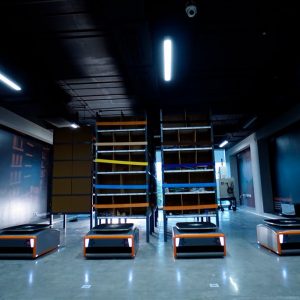There is a robot revolution happening in India and a new generation of robots are filling the warehouses – with manufacturing units, logistics sector, automobile industry, retail and e-commerce sector being the major adopters of warehouse automation. Not much known for its hardware prowess, the shift to robotics also marks India’s foray into hardware behemoth. Of late, India has been the biggest seller of software services, and warehouse automation has put it on the global map as a country reckoned for its hardware competence.
India is pegged as one of the key markets for warehouse automation systems in Asia and analysts believe the country will attract original equipment manufacturers to set up their units, thanks to low production costs. The Indian market for warehouse automation is projected to grow at a CAGR of 10-12% during 2015-2020, and is expected to reach $3.49 billion by 2020.
What’s behind the sudden urge to embrace warehouse automation?
Today, there are many compelling reasons for manufacturers, e-commerce giant, retail and logistics industry to embrace warehouse automation wholeheartedly. The obvious one — warehouse automation improves efficiency and quality of work dramatically and reduces human labour. Besides, improving performance indices, the emergence of industrial hubs and uniform tax structure, GST has also been a push in the right direction and enabled the logistics and supply chain industry to adopt automation. And to become more competitive, players such as in the e-commerce sector will need to substantially reduce the logistics cost, reduce dependence on manpower and cut down supply chain wastes.
Earlier this year, leading supply chain and logistics company Gati KWE and Indian e-commerce giant Flipkart signed on Pitney Bowes TrueSort – an automated parcel sorting system and the Pitney Bowes OneSort automated data capture system. Gati required an efficient automated solution to help manage its large volume of parcels and is now leveraging TrueSort – an automated system that is capable of processing a combination of parcels, polywrap bags, magazines and flats with speed and precision. System. Meanwhile, Flipkart is using OneSort — all-in-one data capture solution that enables users to instantly process instructions for labeling, routing, postal documentation, client billing, and custom reporting while receiving full access to critical information through a comprehensive data stream.
E-commerce companies are not alone in this race. Reportedly, GreyOrange, Singapore and Gurgaon headquartered warehouse automation company that put India on the global map by bagging global clients such as Hong Kong-based Kerry Logistics and Singapore-based logistics company[i] Ninja Van, has even added CPG companies to its roster of clients. The company has its solutions implemented in 55 warehouses in India and abroad and some of its Indian clients are PepperFry, Myntra and DTDC.
Is e-commerce driving warehouse automation?
The e-commerce boom has benefitted many industries, especially the supply and logistics sector wherein data science is applied heavily to for shipment tracking. Now, with the continued rise of online shopping and changing buyer expectations, speed and accuracy of delivery has spurred e-commerce companies to find a faster way to reach customers. According to Warehouse Automation and Control Global Market Research, the retail fulfillment paradigm shift is seeing a new dimension with e-commerce giants competing fiercely to fulfil faster deliveries. That’s where warehouse automation and control system sales is stimulating growth by boosting operational efficiency. Today warehouse automation forms the backbone of e-commerce players in India such as Amazon, Flipkart, Zivame, Myntra among other bold-faced names. Noida-headquartered Falcon Autotech Pvt. Ltd is powering automated solutions inside the sprawling warehouses of leading e-commerce portals. The company’s automated solutions is helping e-tailers reduce turnaround time by a fourth.
Applications of warehouse automation
Self-driving vehicles: By acquiring robot maker Kiva, Amazon added an army of robots to streamline their warehouse operations. The fleet of robots, powered by artificial intelligence are saving the money by carrying products and automating the picking and packing process inside the warehouse, thereby reducing the dependence on personnel.
Automated Inventory Storage: This type of AI-equipped robotic system known as Butler value adds by managing inventories like a professional and reduces order fulfilment efficiently. Produce by GreyOrange, this robotics system can also adapt to the changing inventory and works like a goods-to-person robotic system for automated inventory storage (put-away) and replenishment and are powered by machine learning to pick and combine orders in fulfilment centre. With data from machine learning, the army of Butlers find out the most efficient way to bring products to workers at picking stations.
Sorting it out: This is one of the oldest and most cost-effective way of parcel handling. Sorters use conveyors and scanners to read package barcodes, measure the weight and dimensions and, automatically space them, and put it for distribution. According to Pitney Bowes Parcel Shipping Index, parcel volume is expected to grow by 20% globally by 2018.
Drones: Not an uncommon tool in the US, drones are used by warehouses to ferry one item from one place to the other. Amazon and Walmart have taken the lead in developing a drone workforce combined with RFID technology that could significantly automate inventory management. Drones can also help in real-time monitoring and resolve the out-of-stock problem.
Outlook
From big costs savings to adapting to changing inventory and real-time monitoring, automated warehousing is the future of the industry with a swathe of industry adopting it. Today companies are leveraging automated warehousing to keep pace with customer demands and accelerate delivery. However, there are a few barriers in terms of technology — firstly, companies have to procure imported hardware since there is a marked absence of hardware companies in India that can provide the necessary parts. Indian companies are dependent on their Chinese and American counterparts to fulfil critical components. Secondly, the cost of adopting warehouse automation technology is very high due to the cost of procuring imported hardware components and SMEs want to see a tangible ROI before adopting this technology. Thirdly, there is a huge dearth of talent in India and most colleges don’t have a dedicated program or faculty for this multi-disciplinary stream.
























